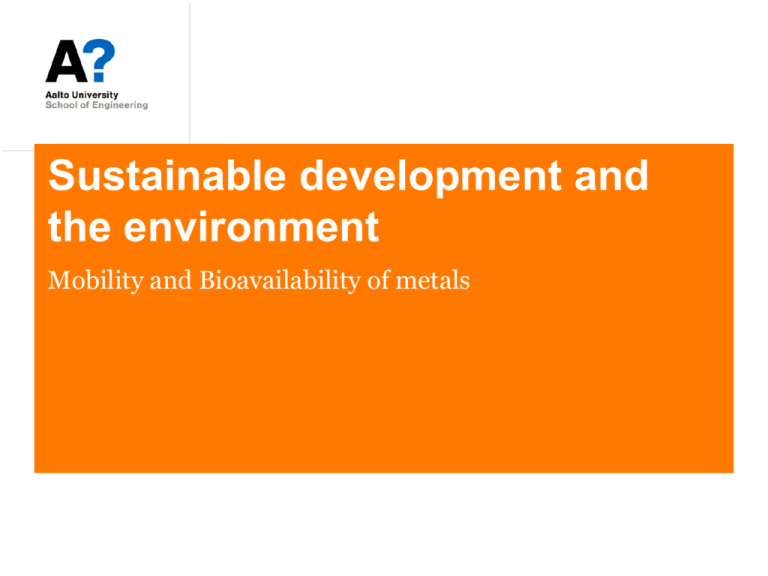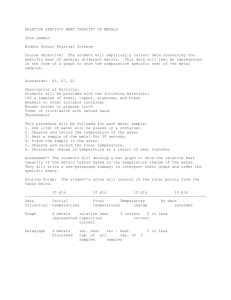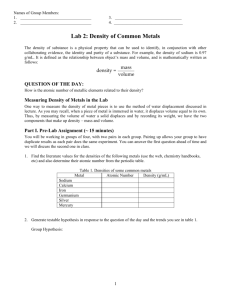Bioavailbility
advertisement

Sustainable development and the environment Mobility and Bioavailability of metals Exposure to environment • • Overall metal bioavailability studies must take in to consideration following Metals can be dispersed in soil and sediment, dissolved in ground and surface water, suspended as particles in surface water, and in pore fluid in sediment . – • • Most adverse effects can result form bioaccumulation of metals by biota in surface water and by plants and animals in terrestrial environments. Bioavailability is a complex function of – – – – • total concentration and speciation (physical-chemical forms) of metals, Mineralogy of soil, rock air particles, pH, redox potential, temperature, total organic content (both particulate and dissolved fractions), suspended particulate content, as well as volume of water, water velocity, and duration of water availability, particularly in arid and semi-arid environments. In addition, wind transport and removal from the atmosphere by rainfall – – • • In addition, metals can be dispersed into the atmosphere, by natural geochemical cycling and by other anthropogenic processes (such as smelting and burning leaded gasoline and coal) and by microbial activities; (frequency is more important than amount) Many of these factors vary seasonally and temporally, and most factors are interrelated. Consequently, changing one factor may affect several others. Poorly understood biological factors seem to strongly influence bioaccumulation of metals and severely inhibit prediction of metal bioavailability Geochemical exploration data • Geochemical exploration searches for anomalies in the concentrations of chemical substances in a region. • In site-specific investigations, geochemistry is a routine procedure (in cold-temperate regions) • the sampling density varies from a couple of meters to several hundred. • In glaciated areas the most common sample material is till, – Contains ground bedrock material – indirectly reflects the composition of bedrock. • In addition to the sampling of soil (till,) a percussion drill may be used to collect samples of drilling mud and crushed rock from the bedrock surface. Selective/sequential leaching • Geochemical exploration uses as a routine so called selective leaching techniques – – – – Aqua regia: pseudo total analysis (not most resistant minerals) Nitric acid (or other strong acid): most silicates and all ore minerals Ammonium oxalate: iron hydroxides Weak (organic) acids: clay minerals, absorbed metals, exchangeable cations, calcite – Diluted salt; Water: soluble minerals salts, sulfates • Extremely useful data for environmental assessments – Speciation of metals – Background and base line – Exposure and risk analysis • Mandatory for design of post-operational activities at sulfideore mines – Treatment of tailings/remediation of soil contamination Example: metal mining wastes with arsenic • • • Speciation of Fe and S in tailings Solubility (sulphates) Oxyhydroxides – solubility varies with redoxconditions – Desorption of metals (e.g. As) • • Distinction of requires sequential/selective leaching tests besides other analyses Negligence of mineralogical studies has lead to “remediation and closure measures” that have just worsened the situation (mobilized As) Environmental information from sequential leaching – Aqua regia: pseudo-total analysis (dissolves almost all, but not all minerals): considered to provide conservative estimates of metal pollution • Does not differentiate mobile or stable speciation – Ammonium oxalate: provides the contents of metals that can be released if oxidized conditions change reduced – Weak (organic) acids: estimates of bioavailable concentrations in soils – Water: soluble minerals salts, sulfates Karabash – soil analysis Metal contents in some tailings and processing wastes are close to economic ore deposits! Using modern methods to mineralogical reprocessing of the mining tailings and wastes could be used to reduce the pollution • Soil sample mineralogy was analysed using XRD, and their chemistry by selective leaching. (blue=bound by adsorption or soluble sulfates, orange=bound by iron(III)hydroxides, yellow=bound by sulphides) Exposure analysis and dose assessment Input to risk based action planning: – Distinguishes the chemicals of concerns – Sets priorities to remediation work – Reflects the present knowledge on health risks Geochemical modelling Physical data Hydrological data Areal extent Volume of waste rock Mean annual temperature Porosity 3.49e+6 m2 8.99e+7 m3 Precipitation Evaporationx +10 oC Bulk density 1695 kg /m3 Water flow rates -to Kazretula river -to Poladauri riverx - discharge to groundwaterx 39 % 700 mm /y 50 % 300 m3 /d Mineralogical composition vol-% # quartz 78 sericite 7 Drainage water chemistry in mg/L * pH 2.65 SO4214794 pyrite 3.1 Fetot 1630 chalcopyrite 0.8 Cu2+ 1100 AMD in Bolnisi Mining Area, Georgia Solute flows to Kazretula River 50 m3 /d sphalerite 0.1 Zn2+ 682 3000 m3 /d chlorite 11 Mg2+ 1100 Mol /s Tonnes /y Solute flows to the streams entering the Poladauri River Mol /s Tonnes /y SO4 0.532 1620 SO42- 0.089 270 SO42- 5.315 16200 Fetot 0.101 178 Fetot 0.017 30 Fetot 1.013 1784 120 2+ 20 2+ 0.601 1204 2+ 0.362 746 1.571 1204 2- Cu Zn 2+ 0.060 2+ 0.036 2+ Mg 0.157 Cu 75 Zn 2+ 120 Mg Mineral contents Mol 2+ 0.010 0.006 Cu 13 0.026 Zn 2+ 20 Mg Mineral weathering rates kg Solute flows infiltrating to the groundwater Mol /s Tonnes /y Mineral lifetimes Mol /s Years pyrite 3.94e +10 4.72e +9 pyrite 2.095 pyrite 596 chalcopyrite 6.64e +9 1.22e +9 chalcopyrite 0.671 chalcopyrite 314 sphalerite 1.56e +9 1.52e +8 sphalerite 0.404 sphalerite 123 chlorite 3.02e +10 1.68e +10 chlorite 0.351 chlorite 2724 Bolnisi-mining area georgiamodel0905_Heads 689.842113 670.564793 651.287472 632.0101509 Irrigation channels 612.73283 593.455509 574.178188 554.900867 Contaminated streams from tailings Y Z X Contaminated river Scope modelling new species 0.99 0.92 0.85 0.78 0.71 0.64 0.57 0.5 0.43 0.36 0.29 0.22 0.15 0.08 0.01 new species 0.985 0.915 0.845 0.775 0.705 0.635 0.565 0.495 0.425 0.355 0.285 0.215 0.145 0.075 0.005 Y Y Z X Z X Toxic metals • Subjects of particular concern include various metals, – chromium, nickel, copper, manganese, mercury, cadmium, and lead, (not forgetting uranium, thorium, radium) • and metalloids, including – arsenic, antimony, and selenium • Near former mine sites, dumps, tailing piles, and impoundments, • In urban areas and industrial centers • Higher than average abundances of these elements in soil, sediment, water, and organic materials, • In some cases due to past mining and (or) industrial activity, may cause the formation of the more bioavailable forms of toxic heavy metals. • Bioavailability is a complex function of – – – – • In addition, to aqueous transport, wind transport and removal from the atmosphere by rainfall – – • • total concentration and speciation (physicalchemical forms) of metals, Mineralogy of soil, rock air particles, pH, redox potential, temperature, total organic content (both particulate and dissolved fractions), suspended particulate content, as well as volume of water, water velocity, and duration of water availability, particularly in arid and semi-arid environments. (frequency is more important than amount) Many of these factors vary seasonally and temporally, and most factors are interrelated. Consequently, changing one factor may affect several others. Poorly understood biological factors seem to strongly influence bioaccumulation of metals and severely inhibit prediction of metal bioavailability Isotopes as tools to assess exposure Toxicity of Zn depends substantially on the hardness of water!! Partitioning of metals in surface waters and sediments • After discharge to an aquatic environment but before uptake by organisms, metals are partitioned between solid and liquid phases. • Within each phase, further partitioning occurs – • determined by ligand concentrations and metal-ligand bond strengths. In solid phases, soil, sediment, and surface water particulates, metals may be partitioned into six fractions: – – – – – – (a) dissolved, (b) exchangeable, (c) carbonate, (d) iron-manganese oxide, (e) organic, (f) crystalline • • Various metals partition differently among these fractions Partitioning is affected strongly by variations in pH, redox state, organic content, and other environmental factors • • The relative mobility and bioavailability of trace metals associated with different fractions are shown in the next slide The dissolved fraction consists of • • carbonate complexes, whose abundance increases with pH, metals in solution, including metal cation and anion complexes and hydrated ions – whose solubilities are affected strongly by pH and tend to increase with decreasing pH Metal mobility and bioavailability Metal species and association Mobility Exchangeable (dissolved) cations High.Changes in major cationic composition may cause a release due to ion exchange (estuarines, mixing of saline groundwater with surface water) Metals associated with Fe-Mn oxides Medium. Changes in redox conditions may cause a release but some metals precipitate if sulfide mineral present is insoluble Metals associated with organic matter Medium/High Decomposition/oxidation of organic matter occurs in time Metals associated with sulfide minerals Strongly dependent on environmental conditions. Under oxygen-rich conditions, oxidation of sulfide minerals leads to release of metals. Metals fixed in crystalline phase Low. Only available after weathering or decomposition Spread of metals in surface water • In mining areas soils have commonly high concentrations of metals • Sediments in streams and lakes in the catchments areas of mineral deposits provide information about – Transport and distribution and partitioning of metals in sediments • Eg. Some of the springs existing in Talvivaara catchment area where discharging acid drainages (pH 3.5!) before the mine was build providing (with black shales present in the region) “an natural analog” for the mine pollution spread (of Ni and U) Particle size effects and “mineral liberation factor” • Particulate size and resulting total surface area available for adsorption – – • Small particles with large surface-area-to-mass ratios allow more adsorption than an equivalent mass of large particles with small surface-area-to-mass ratios. – • • Reduced adsorption can increase metal bioavailability by increasing concentrations of dissolved metals in associated water. The size of particles released during mining depends on mining and beneficiation methods. Finely milled ore may release much smaller particles that can – – • important factors in adsorption processes affect metal bioavailability both be more widely dispersed by water and wind, serve as sites of enhanced adsorption. Consequently, mine tailings released into fine-grained sediment such as silty clays found in many playas can have much lower environmental impact than those released into sand or coarse-grained sediment with lower surface area and adsorption. (Natural attenuation by sorption) Sulfide Oxidation (1) FeS2 + 7/2 O2 + H2O Fe2+ + 2 SO42- + 2 H+ Fe1-xS + (2-x/2) O2 + x H2O (1-x) Fe2+ + SO42- + 2x H+ (2) Fe2+ + 1/4 O2 + 5/2 H2O Fe(OH)3 + 2 H+ Complete oxidation of pyrite: FeS2 + 15/4 O2 + 7/2H2O Fe2+ + 2 SO42- + 4 H+ If oxygen is limited (maximum solubility to groundwater) incomplete oxidation can take place according to (1) If pH is > 3.5, Fe(OH)3 will precipitate • Iron crust can stop neutralization by carbonates • iron-oxy-hydroxides can absorb metal (and they stay there as long as Fe(OH)3 (or other Fe-oxy-hydroxides) are stable: changes in conditions can release them. If however, pH is low (< 5) and oxygen is present the much more acid generating reactions with FeIII can take place ! • In stead of ferric hydroxide (metastable) more complex reactions of ferric oxyhydroxides and hydroxysulfates can take place Secondary Minerals Ferric hydroxides & hydroxysulfates Schwertmannite Fe8O8 (SO4)(OH)6 Jarosite KFe3 (SO4)2(OH)6 Ferrihydrite Fe5OH8•4H2O Goethite a-FeO(OH) Oxidation with Ferric Iron FeS2 + 14 Fe3+ + 8 H2O 15 Fe2+ + 2 SO42- + 16 H+ Fe1-xS + (8-2x) Fe3+ + 4 H2O (9-3x) Fe2+ + SO42- + 8 H+ Fe2+ + ¼ O2 + H+ Fe3+ + ½ H2O These reactions are commonly cathalysed by microbes! Acid generating and secondary minerals producing reactions Sorption of metals on hydrated ferric oxides Representative curves on sorption of metals on ferrous oxy-hydroxides Modelled for 1g/L of ferric oxide-sorbent Representative curves on sorption of oxyanions on ferrous oxy-hydroxides. Modelled for 1g/L of ferric oxide-sorbent Compositional fractioning • • Adsorption is pH-dependent taking place (only) in a certain range of pH The adsorption edge, the pH range over which the rapid change in sorption capacity occurs, varies among metals, – precipitation of different metals over a large range of pH units. • • • • • mixing metal-rich + acidic water with higher pH+ metal-poor water results in fractionation and separation of metals as different metals are adsorbed onto various media over a range of pH values. Cadmium and zinc tend to have adsorption edges at higher pH than iron and copper, and consequently they are likely to be more mobile and more widely dispersed. Adsorption edges also vary with concentration of the complexing agent; thus, increasing concentrations of complexing agent increases pH of the adsorption edge Major cations such as Mg+2 and Ca+2 also compete for adsorption sites with metals and can reduce the amount of metal adsorption Metals in sulphides • In reducing aquatic environments metals from mining activities are commonly associated with sulfide minerals • Either primary (in the ore deposit) or formed by bacterial reduction of the (secondary) sulfates in oxidized tailings. – These reactions are applied in remediation! • Most metal sulfide minerals are quite immobile, as long as they remain in a chemically reducing environment, – may have little impact on biota despite of anomalous metal concentrations Oxidation with Dissolved O2 ZnS + 2 O2 Zn2+ + SO42PbS + 2 O2 PbSO4 Oxidation with Ferric Iron ZnS + 8 Fe3+ + 4 H2O Zn2+ + 8 Fe2+ + SO42- + 8 H+ • In recent organic carbon-rich sediments, trapped interstitial fluids can commonly form a strongly reducing (anoxic) environment. Low redox potential in this environment can promote sulfate reduction and sulfide mineral deposition. – Much of the non-silicate-bound fraction of potentially toxic metals such as arsenic, cadmium, copper, mercury, lead, and zinc, can be co-precipitated with pyrite, form insoluble sulfides, and become unavailable to biota – Seasonal variation in flow rates or storms, floods that induce an influx of oxygenated water can result in rapid reaction of this anoxic sediment and thereby release significant proportions of these metals. • Also co-precipitation of As in oxic environments can be used to bound it efficiently to non-bioavailable form (Ca-Fearsenate with Ca/Fe about 1/6) Metal uptake by plants • • • • • Plant species and relative abundance and availability of necessary elements also control metal uptake rates. Abundant bioavailable amounts of essential nutrients, including phosphorous and calcium, can decrease plant uptake of non-essential but chemically similar elements, including arsenic and cadmium, respectively. More complex interactions are also observed: bioavailability may be related to multi-element amounts or ratios. For example, copper toxicity is related to low abundances of zinc, iron, molybdenum and (or) sulfate). Widely studied in agricultural sciences In the scientific literature, many studies describe anthropogenic (industrial or mining) contributions to elemental abundances, and their bioavailability controls, in the environment. E.g. – – – – occurrence of heavy metals in soil near and far from urban pollution; formation of acid mine drainage; uptake of heavy metals by plants in lab experiments and uptake of metals by vertebrates in the vicinity of zinc smelters Arsenic in groundwater e.g. Finland, public health impacts of arsenic groundwater Hungary Metal up take into aquatic organism • Metal uptake by plants and partitioning in the soil are combined in the aquatic environment. • Two major pathways (uptake vectors) are available for metal incorporation in deposit- and (or) 13 detritus-feeding aquatic species: • (1) ingestion of metal-enriched sediment and suspended particles during feeding, and • (2) uptake from solution • Consequently, knowledge of geochemical reactions of metals in both water and sediment is necessary to understand controls on metal bioavailability in natural water. • Many biological factors controlling metal bioaccumulation in a aquatic organisms are not understood; this fact severely limits our understanding of metal bioavailability – Regulations can be expected to change Acid Neutralization CaCO3 + H+ Ca2+ + HCO32KAlSi3O8 + H+ + 7 H2O K+ + 3H4SiO4 + Al(OH)3 CaAl2Si2O8 + 2 H+ + H2O Ca2+ + Al2Si2O5(OH)4 Acid-Base Accounting FeS2 + 2CaCO3 + 3.75O2 + 1.5H2O = Fe(OH)3 + 2SO42- + Ca2+ + CO2 AP: Acid-producing potential NP: Acid-neutralizing potential NNP: Net neutralizing potential NNP = NP - AP Secondary Minerals Sulfates Highly soluble Melanterite FeIISO4•7H2O Rozenite FeIISO4•4H2O Copiapite FeIIFeIII4(SO4)6(OH)2•20H2O Halotrichite FeIIAl2(SO4)4•22H2O Goslarite ZnSO4•7H2O Moderately Gypsum soluble CaSO4•2H2O Contrary Creek, Virginia Climatic conditions effect the solubility of secondary minerals, particlularly Vermont: peaks after spring discharge Virginia peaks during hot summers Secondary Minerals Aluminum hydroxides & hydroxysulfates Amorphous Al(OH)3 g-Al(OH)3 Jurbanite Al(SO4)(OH)6•5H2O Basaluminite Al4 (SO4)(OH)10•5H2O Gibbsite Secondary Minerals • Metal-sulfate salts – – – • Highly soluble Store acidity and metals Cycle metals via evaporation and dissolution Ferric hydroxides – pH-dependent sorption of metals Classification of Seafloor Massive Sulfide Deposits Volcanic Sediments> Assemblage Volcanics Volcanics= Sediments Volcanics> Sediments Bimodal Felsic>Mafic Bathurst Kuroko Bimodal Sedimentary- Besshi Mafic>Felsic Exhalative Noranda Mafic and Ultramafic Cyprus Uses of Models Mitigation and planning at future mines Remediation at abandoned mines Land-use planning






